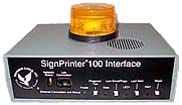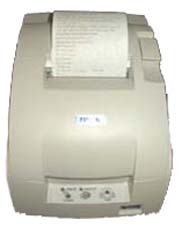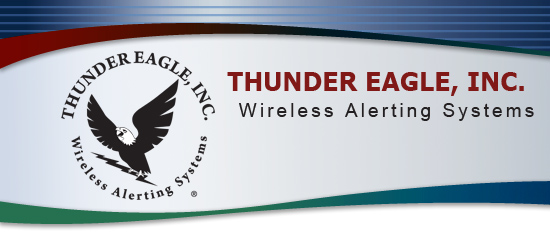Commercial Grade NOAA Weather Radio
Receiver, Scanner, Recorder and Customer Programmable Interface
The WeatherEagle®110 (WE110) and the Weather Eagle®105 (WE105) high performance NOAA weather radio receivers were designed for simple, dependable operation in moderately high RF environments with a two pole helical filter and significant ground shielding.The WE110 and the WE105 decode the 1050-hz wide area alert tone used by the National Weather Service (NWS) to designate weather alert messages.
The WE110 is a smaller footprint version of the WE105 with a few additional features such as a 1050 Hz LED, which is useful in diagnosing problems with the NWR audio and the EAS/SAME signal.
The WE110 is used as the receiver for the Alert Eagle 120 (AE120) EAS/SAME decoder. The WE105 is used as the receiver for the Alert Eagle 400 (AE400) EAS/SAME decoder.
The WE110 is available as both a stand alone and as a rack mounted unit. The rack mount configuration is often used by broadcasters to supply NWR signal to EAS systems. The small footprint of the WE110 makes this unit the choice for emergency response vehicles.
The MRI-100 Multi-Radio Interface connects the WE110 to trunked and conventional radio systems. The MRI-100 permits remote over the air control of the WE110 by DTMF (touch tone) and by ascii text commands across the Internet. The combined MRI-100/ WE110/ AE120 unit can provide beeps only (for high priority communications channels) or audio voice alerts on up to three radio channels. The MRI-100 has successfully been connected to multiple talk groups on trunked radio systems and is used to provide both automatic real time audio severe weather alerts to the field as well as providing live weather on demand through the trunked radio system. Many jurisdictions have written checking and monitoring the weather alerts through this system into their SOP (standard operations plans).
How It Works
The units will beep, un-mutes and an LED will flash when the 1050-Hz alert tone is decoded. Most users disable the 1050-Hz beep and un-muting when the WE105/110 is used for SAME/EAS decoding so the WE110 will only un-mutes upon an EAS/SAME match, and not on every 1050 Hz tone detection.
When the WE105/WE110 detects a 1050 Hz tone, the WE105/110 closes a relay, and the unit goes into alert mode for a user settable period of time between 1 second and 18 hours with the default being 90 seconds. If another alert tone is issued while a first alert is active, the unit will beep, automatically reset and keep the system in alert mode for a new full preset alert period.
The units record the last four minutes of warning audio for later playback and verification. The recording does not need battery back-up. The ‘Record’ LED will flash when the ‘Record’ chip is either recording or playing back an alert.
The WE110 has a 1050-Hz lock LED that indicates when the alert signal is being received when the LED is on solidly, When the NWS transmitter is operating normally the LED will flash randomly. When the NWS transmitter is on the air, but has no audio, the LED will be off. When the transmitter is off the air the LED will be flashing constantly. This is a great diagnostic feature based on the patented FSK lock led on the Alert Eagle® 120 and 400.
LEDs (Light Emitting Diodes) indicate channel selection, scan mode, 1050-Hz alert decoded, and ‘live’ and ‘'play’ modes.
Switches are provided for manual channel selection, scan mode, reset last warning, LED/mute receiver, play and live. All switches are remotely controllable by logic inputs from a 15-pin connector on the rear of the unit and over radio systems through connection with the MRI-100.
The units can easily be configured in the field using a simple, standard terminal communication program such as Hyperterminal (9600 baud 8-N-1) .
The WE110 has many user settable menu configurations such as a setting to have the unit scan each of the seven NWR channels (162.400; 162.425; 162.450; 162.475; 162.500; 162.525; 162.550 MHz) once per minute to automatically change channel to the strongest NWR signal. This is a critical feature in emergency response and disaster recovery communications because normal NWR stations many not be on the air and the emergency vehicle is likely to be outside its home territory so the receiver needs to find the best signal wherever the vehicle is currently located.
The unit can also be set power-up on the last selected channel for reliable EAS/SAME decoding.
Both receivers capture weather alerts from anywhere in the United States and Canada. Other frequencies are available on special order.
WE105/WE110 Specifications:
- Powered by 12-VDC for car, truck and vehicle operations or from 120 VAC wall transformer.
- Two-pole helical filter for high RF environments.
- 16" custom, telescoping antenna with BNC style male-base connector.
- BNC antenna connection for external antennas (50 ohm).
- Draws less than 200 milliamps.
- High gain monolithic RF amplifier for weak RF signals.
- Pulse-width modulated ‘beep’ alert and switch-press acknowledgment.
- Digital-signal-processed 1050-Hz tone detector.
- Un-muted RCA connector for external audio output with its own volume control required for input into external EAS/SAME systems.
- Muted RCA connector for public address and other communication systems.
- Double pole/double throw relay logic output that closes on decoding the 1050-Hz alert tone.
- Menu option to close relay on ‘live/play’ and ‘alert’ for easy interfacing.
- Menu option to time out (1 second to 18 hours) after the ‘live’ button is pressed to permit easy interface into other systems that permit the user to hear live weather audio and then have the radio automatically reset.
- U-Bracket available for mobile installation as an option.
- Electrical interface (TTL logic) for remote control of manual, scan, play, live and reset operations (active high + 5vdc).
- Microprocessor controlled with field upgradeable firmware with optional programmer.
- Local speaker with front panel audio control.
- Highly sensitive at least 0.40 uV for 12db.
- Busy logic input for repeater operations to avoid the alert signal from interfering with a communication in progress on a repeater.
- Frequency-synthesized receiver.
- RS-232 9600-baud serial output for diagnostics, such as RSSI (Received Signal Strength Indication) and 1050-Hz tone detection.
- Modern, surface-mount construction.
- 19-inch rack-mountable (option).
- 500 milliamp 12 VDC wall transformer with 2.1 mm center positive barrel connector or 12VDC power connector without transformer.
- FCC Part 15 and Industrie Canada type accepted.
|

WE110 – Stand-alone Receiver

WE110R-Rack Mount

WE110 Receiver -
AE120 SAME-EAS Decoder

WE105 Receiver -
AE400 SAME-EAS
Decoder
Translates Alerts to Text

MRI-100 MultiRadio Interface

FipsServer Custom Weather Website

SP100 SignPrinter Interface

One Line LED Signboard

Two Line LED Signboard

Rugged Printer

Strobe Light
|






